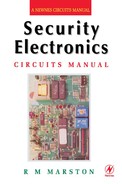Preface
Modern electronic security circuits and systems range in complexity from the simple electronic door-bell to the ultra-sophisticated wireless burglar alarm system that comes complete with an array of passive infra-red (PIR) movement detectors and contact sensors plus full remote-control and sensor-monitoring facilities. Electronic security systems have a wide range of applications in the home, in industry and commerce, and in automobiles. They can be designed to be activated by physical contact or by body proximity, or by variations in heat, light, or infra-red radiation levels, or in voltage, current, resistance or some other electrical property. This new wide-ranging 55 000-word manual explains – with the aid of 231 illustrations – the operating principles of the most important types of modern electronic security systems and – where applicable – provides the reader with a wide range of practical application circuits.
The manual is split into eight chapters. The opening chapter gives a concise description of electronic security system basic principles and devices, and all subsequent chapters describe practical security systems and circuits. Chapter 2 deals with ‘contact-operated’ circuits, which activate when an electrical switch or wiring circuit is opened or closed. Chapter 3 deals with optoelectronic circuits that are activated by visible light or by infra-red radiation, and Chapter 4 describes modern anti-burglary circuits and systems.
Chapter 5 of the book looks at temperature-sensitive security circuits, and Chapters 6 and 7 look at circuits that are meant for use in instrumentation applications, or are specifically designed for use in automobiles. The final chapter looks at a miscellaneous collection of practical security circuits that are activated by the presence of a liquid, steam, or gas, by sound, by the failure of AC power supplies, by the close or near proximity of a person or object, by human touch, or by the breaking of an ultrasonic beam, etc.
This book, like all others in the Newnes Circuits Manual Series, is aimed at practical design engineers, technicians and experimenters, but will also be of great interest to all amateurs and students of electronics. It deals with its subject in an easy-to-read, down-to-earth, mainly non-mathematical but very comprehensive manner. Each chapter explains the basic principles of its subject and – where appropriate – presents the reader with a wide selection of practical application circuits, all of which have been designed and fully evaluated by the author.
Throughout the volume, great emphasis is placed on practical ‘user’ information and circuitry; most of the ICs and other devices used in the practical circuits are modestly priced and readily available types, with universally recognized type numbers. All of the book’s diagrams have been generated by the author, using a basic ‘Corel DRAW 3’ graphics package.
In this book, the values of resistors and capacitors, etc., are notated in the International style that is now used throughout most of the western world, but which may not be familiar to some ‘hobbyist’ readers in the USA. Such readers should thus note the following points regarding the use of the International notation style in circuit diagrams:
(1) In resistance notation, the symbol R represents units of resistance, k represents thousands of units, and M represents millions of units. Thus, 10R = 10Ω, 47k = 47kΩ, 47M = 47MΩ.
(2) In capacitance notation, the symbols μ, n (= 1000pf), and p are used as basic multiplier units. Thus, 47μ = 47μF, 10n = 0.01μF, and 47p = 47pF.
(3) In the international notation system, decimal points are not used in notations and are replaced by the multiplier symbol (such as V, k, n, μ, etc.) applicable to the individual component value. Thus, 4V7 = 4.7V, 4k7 = 4.7kΩ, 4n7 = 4.7nF, and 1n0 = 1.0n.
